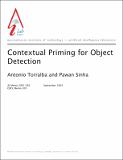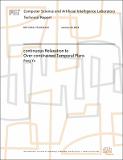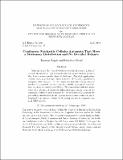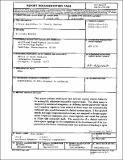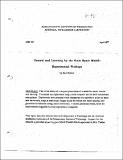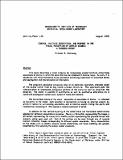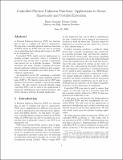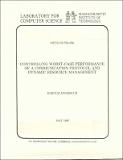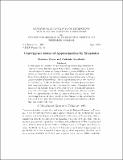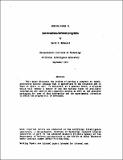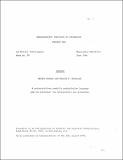Browsing Computer Science and Artificial Intelligence Lab (CSAIL) by Title
Now showing items 732-751 of 3804
-
Contextual Priming for Object Detection
(2001-09-01)There is general consensus that context can be a rich source of information about an object's identity, location and scale. In fact, the structure of many real-world scenes is governed by strong configurational rules akin ... -
continuous Relaxation to Over-constrained Temporal Plans
(2013-01-25)When humans fail to understand the capabilities of an autonomous system or its environmental limitations, they can jeopardize their objectives and the system by asking for unrealistic goals. The objective of this thesis ... -
Continuous Space-Time Semantics Allow Adaptive Program Execution
(2007-07)A spatial computer is a collection of devices filling spacewhose ability to interact is strongly dependent on theirproximity. Previously, we have showed that programmingsuch a computer as a continuous space can allow ... -
Continuous Stochastic Cellular Automata that Have a Stationary Distribution and No Detailed Balance
(1990-12-01)Marroquin and Ramirez (1990) have recently discovered a class of discrete stochastic cellular automata with Gibbsian invariant measures that have a non-reversible dynamic behavior. Practical applications include more ... -
Contour Matching Using Local Affine Transformations
(1992-04-01)Partial constraints are often available in visual processing tasks requiring the matching of contours in two images. We propose a non- iterative scheme to determine contour matches using locally affine transformations. ... -
A Control Algorithm for Chaotic Physical Systems
(1991-10-01)Control algorithms which exploit the unique properties of chaos can vastly improve the design and performance of many practical and useful systems. The program Perfect Moment is built around such an algorithm. Given ... -
Control Algorithms for Chaotic Systems
(1991-03-01)This paper presents techniques that actively exploit chaotic behavior to accomplish otherwise-impossible control tasks. The state space is mapped by numerical integration at different system parameter values and ... -
Control and Estimation for Cooperative Manipulator Tasks
(2006-02-28)The objective of this project is to achieve reliable transfer of an object from one robotic manipulator to another. This capability is useful for a number of applications, for instance robotic assembly, or robots with ... -
Control and Learning by the State Space Model: Experimental Findings
(1977-04-01)This is the second of a two part presentation of a model for motor control and learning. The model was implemented using a small computer and the MIT -Scheinman manipulator. Experiments were conducted which demonstrate ... -
Control of a Tendon Arm
(1981-02-01)The dynamics and control of tendon driven three degree of freedom shoulder joint are studied. A control scheme consisting of two phases has been developed. In the first phase, approximation of the time optimal control ... -
The Control of Human Arm Movement Models and Mechanical Constraints
(1990-05-01)A serial-link manipulator may form a mobile closed kinematic chain when interacting with the environment, if it is redundant with respect to the task degrees of freedom (DOFs) at the endpoint. If the mobile closed chain ... -
Control of Vibration in Mechanical Systems Using Shaped Reference Inputs
(1988-01-01)Dynamic systems which undergo rapid motion can excite natural frequencies that lead to residual vibration at the end of motion. This work presents a method to shape force profiles that reduce excitation energy at the ... -
Control, Multiple Description, and Purpose in the Visual Perception of Complex Scenes: A Pogress Report
(MIT Artificial Intelligence Laboratory, 1975-08)This memo describes a vision program for recognizing simple furniture comprising assemblies of blocks, in which the same item may be composed in diverse ways. As such, it is concerned with three theoretical issues, perceptual ... -
Controlled Information Sharing in a Computer Utility
(1969-10)A computer utility is envisioned as a large, multi-access computer system providing its users with the ability to store information and share its use with other system users. This thesis considers the nature of information ... -
Controlling Worst-case Performance of a Communication Protocol and Dynamic Resource Management
(1987-05)This paper raises a fundamental questions, neglected so far in the literature: how to make a distributed algorithm robust against input errors and wrong probabilistic assumptions about the distribution of the inputs or of ... -
Convergence Rates of Approximation by Translates
(1992-03-01)In this paper we consider the problem of approximating a function belonging to some funtion space Φ by a linear comination of n translates of a given function G. Ussing a lemma by Jones (1990) and Barron (1991) we show ... -
Convergence Results for the EM Approach to Mixtures of Experts Architectures
(1993-11-01)The Expectation-Maximization (EM) algorithm is an iterative approach to maximum likelihood parameter estimation. Jordan and Jacobs (1993) recently proposed an EM algorithm for the mixture of experts architecture of ... -
Conversations Between Programs
(MIT Artificial Intelligence Laboratory, 1974-09)This paper discusses the problem of getting a computer to speak, generating natural language that is appropriate to the situation and is what it wants to say. It describes, at a general level, a program which will embody ... -
CONVERT
(1966-06-01)A programming language is described which is applicable to problems conveniently described by transformation rules. By this we mean that patterns may be prescribed, each being associated with a skeleton, so that a series ...

